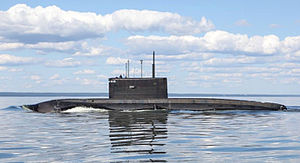Kilo class

Russian Black Sea Fleet's B-265 Krasnodar Improved Kilo-class submarine on the eve of Submariner Day.
|
|
| Class overview | |
|---|---|
| Builders: |
|
| Operators: | |
| Preceded by: | Tango class |
| Succeeded by: | Lada class |
| In commission: | December 1980 |
| Completed: | 70 |
| Active: | 59 |
| Retired: | 2 |
| General characteristics | |
| Displacement: |
|
| Length: | 70.0–74.0 m (229 ft 8 in–242 ft 9 in) |
| Beam: | 9.9 m (32 ft 6 in) |
| Draft: | 6.5 m (21 ft 4 in) |
| Installed power: | Diesel-electric |
| Propulsion: |
|
| Speed: |
|
| Range: |
|
| Endurance: | 45 days |
| Test depth: |
|
| Complement: | 52 |
| Armament: |
|
The Kilo class is the NATO reporting name for a naval diesel-electric submarine that is made in Russia. The original version of the vessels were designated Project 877 Paltus (Halibut) in Soviet Union. There is also a more advanced version, designated as Improved Kilo-class submarine in the West, and Project 636 Varshavyanka in Russia.
These attack submarines are mainly intended for anti-shipping and anti-submarine operations in relatively shallow waters. Original Project 877 boats are equipped with Rubikon MGK-400 sonar system (with NATO reporting name Shark Gill), which includes a mine detection and avoidance sonar MG-519 Arfa (with NATO reporting name Mouse Roar).
Newer Project 636 boats are equipped with improved MGK-400EM, with MG-519 Arfa also upgraded to MG-519EM. The improved sonar systems have reduced the number of operators needed by sharing the same console via automation.
Anechoic tiles are fitted on casings and fins to absorb the sound waves of active sonar, which results in a reduction and distortion of the return signal. These tiles also help attenuate sounds that are emitted from the submarine, thus reducing the range at which the sub may be detected by passive sonar.
The Kilo class was to have been succeeded by the Lada class. In November 2011, the Russian Navy announced that the Lada class will not enter service because trials with the lead boat of the new class, Sankt Peterburg (B-585) had shown major deficiencies. Construction of two further boats was suspended.
On 27 July 2012, the Russian Navy commander-in-chief announced that construction of the Lada-class submarines will resume, having undergone design changes.
One Kilo-class submarine, B-871, was equipped with pump-jet propulsion.
...
Wikipedia
